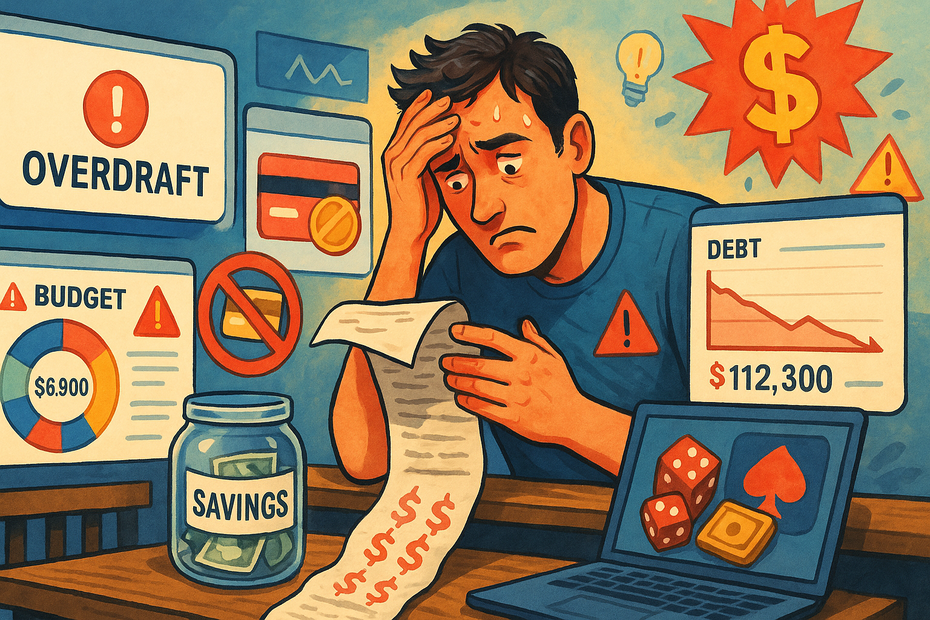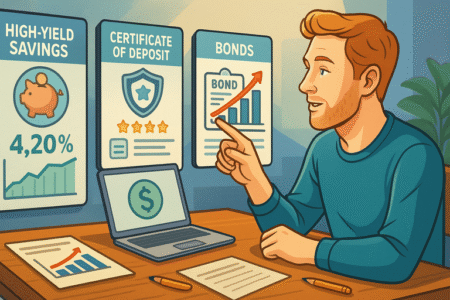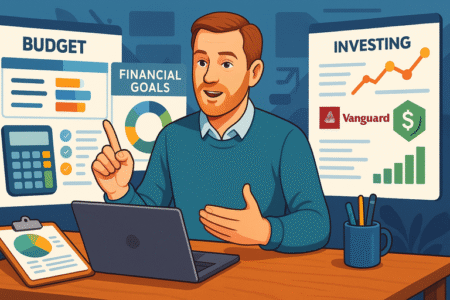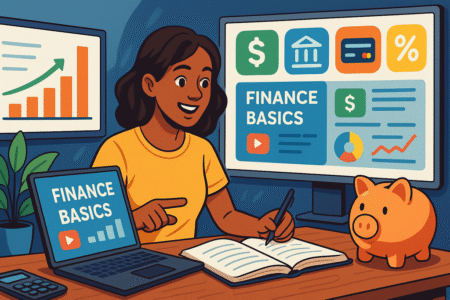Table of Contents
Money finance mistakes don’t just happen once—they build up quietly over time.
Have you ever wondered why no matter how much you earn, your savings never seem to grow? Or why unexpected expenses always throw you off track?
The truth is, most people fall into the same financial traps without realizing it. In this article, we’ll uncover the biggest money finance mistakes that keep you broke and how to avoid them so you can finally start building real wealth.
Ignoring A Realistic Monthly Budget
Skipping a budget is like trying to drive with your eyes closed — you’re moving, but you have no clue where you’re heading.
A monthly budget isn’t just about limiting spending; it’s about giving your money a job so it works for you instead of slipping away unnoticed.
Why Skipping A Budget Leaves You Vulnerable
Without a budget, your money disappears into the cracks of daily life — coffee runs, quick online purchases, that dinner you forgot to account for. When there’s no plan, your expenses expand to fill your income, leaving nothing left over for savings or goals.
I’ve seen this play out over and over: someone earns more, thinks they’ll finally get ahead, but ends up broke again because lifestyle spending creeps up.
A budget acts as a guardrail. It shows where your money leaks and helps you fix it before you fall into debt. In simple terms: no budget equals no control.
Simple Steps To Create A Budget That Actually Works
Here’s how to get started without overcomplicating things:
- Track last month’s expenses — Look at your bank statement and categorize what you spent.
- Set spending categories — Housing, food, transport, entertainment, debt repayment, savings.
- Assign percentages — For example, 50% needs, 30% wants, 20% savings. Adjust based on your reality.
- Automate where possible — Have savings and debt payments leave your account first so you can’t spend them.
- Review weekly — Budgets aren’t set in stone; tweak them until they reflect your real life.
The key isn’t perfection. It’s consistency. I always advise people to start small, track for two months, and adjust instead of aiming for a flawless plan from day one.
Common Budgeting Apps That Make Tracking Easier
If you hate spreadsheets, apps make this painless:
- YNAB (You Need A Budget): Assigns every dollar a job and forces you to be intentional.
- Mint: Automatically syncs with your accounts and tracks spending categories.
- EveryDollar: Simple zero-based budgeting app that’s great for beginners.
- Spendee: Allows shared budgets, perfect if you’re managing finances with a partner.
A smart trick I use: set up real-time notifications. Apps like Mint can ping you when you overspend in a category, which is like having a gentle accountability partner in your pocket.
Relying Too Much On Credit Cards
Credit cards aren’t evil, but leaning on them as your main money tool is like walking on thin ice — one misstep and you’re in deep debt.
Used right, they build credit and offer perks; used wrong, they keep you broke for years.
The Hidden Costs Of Credit Card Debt
Let’s say you rack up $5,000 in credit card debt with a 20% interest rate and only pay the minimum each month. That debt can balloon into $12,000 over time, and you’ll be stuck paying for past purchases long after you’ve forgotten them.
Credit cards feel harmless because swiping doesn’t trigger the same pain as handing over cash. But high interest means you’re renting your lifestyle at a premium.
And here’s the kicker: credit card companies design it this way. Minimum payments are structured to benefit them, not you.
How To Use Credit Cards Without Falling Into A Trap
Here are a few ground rules I live by:
- Never carry a balance. If you can’t pay it off at month’s end, don’t charge it.
- Use credit only for budgeted purchases (like groceries you’ve already accounted for).
- Set alerts when you hit 30% of your credit limit. Going over hurts your credit score.
- Pay twice a month if needed. This reduces interest and keeps utilization low.
Think of your credit card as a tool, not extra income. It’s like borrowing a chainsaw — powerful if handled correctly, dangerous if used recklessly.
Proven Strategies To Pay Off Credit Card Balances Faster
If you’re already in the hole, here’s how to climb out:
- Snowball method: Pay off the smallest balance first for quick wins.
- Avalanche method: Focus on the highest interest card first to save more money long-term.
- Balance transfer cards: Move your balance to a 0% interest card (just watch the fees and time limits).
- Debt consolidation loan: Replace multiple high-interest payments with one lower-rate loan.
I advise setting up auto-pay above the minimum so you chip away faster without relying on willpower alone. Even an extra $50 a month toward principal can cut repayment time dramatically.
Not Building An Emergency Fund
Life has a way of throwing curveballs: car breakdowns, medical bills, job loss. Without an emergency fund, those moments push you straight into debt.
This mistake keeps people stuck in a cycle of financial stress.
Why An Emergency Fund Protects Your Financial Stability
An emergency fund isn’t about paranoia; it’s about peace of mind. Imagine losing your job tomorrow. With three months of expenses tucked away, you’re stressed but stable. Without it, you’re scrambling, borrowing, and falling deeper into financial quicksand.
I’ve found that people with emergency savings make better money decisions overall because they’re not operating from panic. It’s easier to avoid predatory loans or credit card debt when you have a safety net.
How Much Should You Actually Save For Emergencies
The rule of thumb: 3–6 months of living expenses. If you’re single and renting, closer to 3 months may work. If you have kids, a mortgage, or unstable income, aim for 6 months or more.
Start small if that feels impossible. Even $500 can cover car repairs or a medical co-pay and prevent credit card debt. Build from there in steps:
- Step 1: $1,000 starter fund
- Step 2: 1 month’s expenses
- Step 3: Work up to 3–6 months
Progress matters more than perfection.
Easy Ways To Start Saving Even On A Tight Income
Here’s how to carve out money even if your budget feels maxed out:
- Automate savings: Set up a separate account and move even $25 per paycheck automatically.
- Cut one recurring bill: Cancel a subscription you don’t use, or downgrade your phone plan.
- Use windfalls: Tax refunds, bonuses, or side-hustle income go straight into your emergency fund.
- Try a “no-spend” challenge: Pick one weekend a month to spend nothing and stash the savings.
One personal hack I love: I named my savings account “Do Not Touch.” It sounds silly, but that label makes me think twice before withdrawing. It’s like tricking your brain into protecting your future self.
Overspending On Lifestyle Choices
The easiest way to stay broke, even with a good income, is to keep upgrading your lifestyle faster than your bank balance can handle.
A nicer car, bigger apartment, or fancy dinners don’t look like much individually, but over time they chain you to a cycle of “earn more, spend more.”
The Psychology Behind Lifestyle Inflation
Lifestyle inflation sneaks up slowly. You get a raise and think, “I deserve to treat myself.” There’s nothing wrong with that, but the problem is when every bump in income becomes an excuse to add new expenses instead of building wealth.
Psychologists call it hedonic adaptation. That big purchase makes you happy for a while, but soon it feels normal, so you look for the next upgrade. It’s like running on a treadmill: you’re moving faster but not getting anywhere.
I’ve noticed that people don’t usually overspend because they’re careless, but because they confuse wants with needs. That shift in perception is powerful — it keeps you broke without you realizing it.
Practical Ways To Avoid Lifestyle Creep
Here’s how to fight it without feeling deprived:
- Freeze fixed costs: Keep your housing and car costs steady, even if your income grows.
- Create a “raise rule”: Whenever you get a raise, put at least 50% of it into savings or investments.
- Track subscriptions: A $10 monthly subscription feels harmless, but stack 6–7 of them and it’s a hidden drain.
- Use cash for wants: Physically handing over cash helps you feel the cost more than a card swipe.
I suggest making a “luxury list” where you rank wants. When extra income comes in, pick the top item instead of saying yes to everything. That way you’re still enjoying your money, but with intention.
How To Enjoy Life Without Draining Your Finances
A budget doesn’t mean you can’t live well. It means living smart. Here are ways to balance fun and responsibility:
- Set aside a “guilt-free” fund each month just for fun. Spend it however you like — but when it’s gone, it’s gone.
- Choose experiences over things. A trip with friends often brings more lasting joy than another gadget.
- Plan splurges. A $300 spontaneous buy hurts. But saving $50 a month toward that same item makes it stress-free.
I believe money should serve you, not guilt-trip you. The goal isn’t to cut joy, but to make sure your spending matches your values instead of habits.
Neglecting Long-Term Investments
Saving is safe, but relying on savings alone is like trying to fill a swimming pool with a teacup — it’ll never grow fast enough to meet future needs.
Ignoring investments is one of the biggest money finance mistakes because inflation quietly eats away at cash sitting idle.
Why Relying On Savings Alone Isn’t Enough
Imagine keeping $10,000 in a savings account with 1% interest while inflation runs at 3%. After ten years, your money’s buying power has shrunk by almost 20%. Savings accounts are great for safety, not growth.
I like to think of it this way: savings protect today, investments protect tomorrow. If you want financial independence, you need both. Without investing, you’ll always be chasing income instead of letting your money grow while you sleep.
Beginner-Friendly Investment Options To Consider
If investing feels intimidating, start simple:
- Employer retirement plans (401k, pension, etc.): Free money if your employer matches contributions.
- Index funds: These track the market and spread your risk. Platforms like Vanguard and Fidelity make them easy to access.
- ETFs (Exchange-Traded Funds): Like index funds but tradable like stocks, offering flexibility.
- Robo-advisors (Betterment, Wealthfront): Automated investing tools that choose and balance portfolios for you.
The best part? You don’t need a lot to start. Some apps let you invest with as little as $5, so the barrier is lower than ever. I suggest starting with a “set it and forget it” option like index funds before trying to pick individual stocks.
Mistakes To Avoid When Starting Out In Investing
Common beginner pitfalls I’ve seen (and made myself):
- Trying to time the market: You’ll never predict every rise and fall. Consistency beats timing.
- Ignoring fees: High-fee funds quietly eat into long-term returns. Always check expense ratios.
- Not diversifying: Putting all your money in one stock (or one type of asset) is gambling, not investing.
- Pulling money too soon: The market dips. It always has, always will. Panicking and selling is the fastest way to lock in losses.
Think long-term. Investing is a marathon, not a sprint. Your future self will thank you for starting early and staying patient.
Failing To Track Daily Expenses
Small leaks sink big ships. Daily expenses — the coffee, snacks, rideshares — seem harmless, but they add up faster than most people realize.
Not tracking them leaves you wondering where your money went at the end of every month.
How Small Purchases Add Up To Big Money Losses
Here’s a quick example: a $5 coffee every workday costs $100 a month, or $1,200 a year. That’s not “just coffee” — that’s a plane ticket, a month of rent in some cities, or a solid chunk of emergency savings.
This isn’t about never buying coffee. It’s about awareness. The danger is that many small expenses go unnoticed, and when stacked together, they quietly eat your budget. From my experience, most people underestimate their small spending by at least 20–30%.
Easy Tools To Monitor Where Your Money Really Goes
Tracking doesn’t have to be a chore. Here are tools that make it easy:
- Mint: Connects to your bank accounts and automatically categorizes spending.
- YNAB: Helps you proactively assign each dollar before you spend it.
- Spendee: Good for couples or shared expenses.
- Excel/Google Sheets: Perfect if you like control and manual entry.
Pro tip: most banks now have built-in spend trackers in their apps. Look for a “spending insights” or “trends” tab — it’s usually hidden in the menu. That’s a quick, free way to get a reality check without downloading anything new.
A Simple Habit That Makes Expense Tracking Effortless
If apps feel overwhelming, here’s the easiest trick: every time you buy something, round it up and log it in your notes app. For example, if you spend $4.25, write down $5. It takes seconds, but the rounded-up number is easier to remember and gives you a buffer.
Another method I recommend is a weekly “money check-in.” Sunday evening, glance at your spending for the week. It takes five minutes and keeps you from drifting too far off course.
The point isn’t to track forever — it’s to build awareness. Once you know your real habits, you can adjust without feeling deprived.
Not Planning For Retirement Early Enough
Retirement feels like a far-off problem, which is why many people push it aside. The reality? The earlier you start, the less painful it is.
Waiting too long means you’ll need to save far more later just to catch up.
Why Waiting Too Long Hurts Your Future Wealth
Let me give you a simple scenario. If you start investing $300 a month at age 25 and stop at 35, you could still retire with over $500,000 at a 7% return. If you wait until 40 and save that same $300 every month until 65, you’ll end up with less than the early starter. That’s the power of compounding — money growing on top of money.
Delaying even a few years can mean working longer than you’d like, or relying on Social Security alone, which often isn’t enough. Think of early retirement planning as planting a tree — the earlier it’s in the ground, the stronger it grows.
How To Start Retirement Planning Even With Limited Income
You don’t need a six-figure salary to start building a retirement cushion. Here’s how to get moving:
- Start with small percentages: Even 3–5% of income adds up when invested consistently.
- Automate contributions: Have money leave your paycheck before you can touch it.
- Use windfalls wisely: Tax refunds or bonuses can kickstart your retirement fund.
- Cut one expense to replace with investing: Swap a $50 monthly subscription for a $50 retirement contribution.
I suggest setting a baseline goal like “just get started.” Even if it’s only $50 a month, it’s the habit that matters most in the beginning.
Retirement Accounts That Help You Grow Money Faster
There are accounts built specifically to grow retirement wealth:
- 401(k): Often comes with employer matching — always grab that match, it’s free money.
- IRA (Individual Retirement Account): Traditional IRA gives tax breaks now, Roth IRA gives tax-free withdrawals later.
- SEP IRA or Solo 401(k): Perfect for freelancers or self-employed workers.
I always advise diversifying between pre-tax and after-tax accounts if you can. That way you’ll have flexibility when it’s time to actually spend the money.
Ignoring High-Interest Debt Payments
Carrying high-interest debt is like trying to climb a mountain with a backpack full of rocks. It keeps you weighed down, no matter how hard you work.
The True Cost Of Carrying High-Interest Loans
Let’s say you owe $10,000 on a credit card at 20% APR. If you only make minimum payments, you’ll pay back more than double that amount over the years.
That’s money you could’ve invested or saved, but instead, it lines the lender’s pocket.
Debt at 15–25% interest grows faster than almost any investment return. If you don’t prioritize it, you’ll always be running in place.
Steps To Prioritize And Pay Off Debts Effectively
Here’s a system I recommend:
- List all debts with their balances, interest rates, and minimum payments.
- Choose your payoff method:
- Avalanche method: Pay extra toward the highest interest first.
- Snowball method: Pay the smallest debt first for quick wins.
- Automate payments: Set auto-pay slightly above the minimum so you chip away faster.
- Use extra income: Side hustles, bonuses, or tax refunds should go straight to debt.
From my experience, the avalanche method saves the most money, but the snowball builds momentum. Choose whichever helps you stick with it.
Debt Consolidation Options That Can Save You Money
If the debt feels overwhelming, consolidation can simplify things:
- Balance transfer credit cards: Move debt to 0% APR for 12–18 months (just pay attention to transfer fees).
- Personal loans: Replace multiple payments with one lower-interest loan.
- Credit counseling services: Nonprofit programs can negotiate lower rates with creditors.
I recommend running the numbers in a loan calculator before deciding. Sometimes consolidation looks good on paper but ends up costing more in fees.
Living Without Clear Financial Goals
Without clear goals, money just flows in and out like water through a sieve. Goals give your money direction and purpose.
Why Money Finance Goals Give You Direction
Think of your money like GPS. Without a destination, you’ll just wander. Goals act as coordinates, helping you decide whether to save, spend, or invest. They also keep you motivated when sacrifice feels tough.
For example, saving “to have money someday” doesn’t inspire action. Saving “for a down payment on a $250,000 home in three years” does.
How To Set Achievable Short And Long-Term Goals
Here’s how I break it down:
- Short-term goals (1–3 years): Emergency fund, debt payoff, travel savings.
- Mid-term goals (3–7 years): Down payment on a house, starting a business.
- Long-term goals (10+ years): Retirement, financial independence, kids’ education.
Use the SMART method — specific, measurable, achievable, relevant, time-bound. Instead of “save more,” try “save $5,000 for emergencies in 12 months.”
Tracking Progress To Stay Motivated And Accountable
Progress tracking makes goals stick. A few methods:
- Visual trackers: Use a chart or app that lets you color in progress.
- Account nicknames: Rename savings accounts things like “Italy Trip 2026” or “Freedom Fund.”
- Regular check-ins: Review goals monthly and celebrate milestones.
I suggest sharing one of your goals with a friend or partner. Accountability makes it harder to drift off track.
Avoiding Professional Financial Guidance
Many people think financial advisors are only for the wealthy, but that mindset can keep you stuck. A little professional help can prevent costly mistakes.
When It’s Time To Seek Expert Money Finance Advice
You might benefit from advice if:
- You’re juggling multiple debts and don’t know where to start.
- You’re unsure how to invest for retirement.
- You’re facing major life changes (marriage, kids, home purchase).
- You’re earning more but not seeing your wealth grow.
I believe the best time to seek guidance is before you feel overwhelmed. That way you’re proactive instead of reactive.
Affordable Ways To Access Financial Planning Help
Not all advice costs thousands of dollars. Options include:
- Fee-only advisors: Charge by the hour or flat rate, not commission.
- Robo-advisors: Automated platforms that manage investments for a small fee.
- Credit unions or community programs: Often offer free financial counseling.
- Employer benefits: Some workplaces provide financial wellness services.
A session with a financial coach might cost less than a weekend trip but can save you thousands long-term.
Mistakes To Avoid When Choosing A Financial Advisor
Not every advisor has your best interests at heart. Watch out for:
- Commission-based selling: If they push products you don’t understand, be cautious.
- Lack of credentials: Look for CFP (Certified Financial Planner) or fiduciary status.
- Vague strategies: A good advisor gives clear, actionable steps, not just buzzwords.
I always recommend asking upfront, “How do you get paid?” If the answer feels slippery, find someone else.
Expert Tip To Break Free From These Mistakes
You don’t have to fix everything at once. Pick one mistake from this list and focus on that for the next 30 days. Whether it’s building a starter emergency fund, cutting lifestyle creep, or tackling high-interest debt, progress stacks over time.
Here’s my favorite mindset shift: think of every dollar as an employee. If you waste it, it does nothing. If you put it to work (in savings, investments, or debt payoff), it shows up every day and helps you build wealth.
Money finance is less about perfection and more about direction. Small steps done consistently will get you further than big promises you never follow through on.






